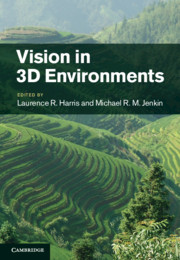Book contents
- Frontmatter
- Contents
- List of contributors
- 1 Seeing in three dimensions
- Part I Depth processing and stereopsis
- Part II Motion and navigation in 3D
- 8 Stereoscopic motion in depth
- 9 Representation of 3D action space during eye and body motion
- 10 Binocular motion-in-depth perception: contributions of eye movements and retinal-motion signals
- 11 A surprising problem in navigation
- Part III Natural-scene perception
- Author Index
- Subject Index
9 - Representation of 3D action space during eye and body motion
from Part II - Motion and navigation in 3D
Published online by Cambridge University Press: 05 August 2011
- Frontmatter
- Contents
- List of contributors
- 1 Seeing in three dimensions
- Part I Depth processing and stereopsis
- Part II Motion and navigation in 3D
- 8 Stereoscopic motion in depth
- 9 Representation of 3D action space during eye and body motion
- 10 Binocular motion-in-depth perception: contributions of eye movements and retinal-motion signals
- 11 A surprising problem in navigation
- Part III Natural-scene perception
- Author Index
- Subject Index
Summary
Introduction
Perhaps the most characteristic aspect of life, and a powerful engine driving adaptation and evolution, is the ability of organisms to interact with the world by responding adequately to sensory signals. In the animal kingdom, the development of a neural system that processes sensory stimuli, learns from them, and acts upon them has proven to be a major evolutionary advantage in the struggle for existence. It has allowed organisms to flee danger, actively search for food, and inhabit new niches and habitats at a much faster pace than ever before in evolutionary history.
The more complex animals became, the more extensive and specialized became their nervous system (Randall et al., 1997). Whereas some simple invertebrates such as echinoderms lack a centralized brain and have only a ring of interconnected neurons to relay sensory signals, vertebrates such as mammals have developed a highly specialized neural network, consisting of a central and a peripheral nervous system, in which each subunit has its own functional properties in controlling the body. While the spinal cord and brainstem are involved in controlling automated, internal vegetative processes such as heartbeat, respiration, and reflexes, the prosencephalon (the forebrain, containing the neocortex) has specialized in so-called higher-order functions, such as perception, action, learning, memory, emotion, and cognition (Kandel et al., 2000). The specialization of the neural control of movement is a major feature that distinguishes primates from other animals.
Information
- Type
- Chapter
- Information
- Vision in 3D Environments , pp. 187 - 207Publisher: Cambridge University PressPrint publication year: 2011
Accessibility standard: Unknown
Why this information is here
This section outlines the accessibility features of this content - including support for screen readers, full keyboard navigation and high-contrast display options. This may not be relevant for you.Accessibility Information
- 1
- Cited by
